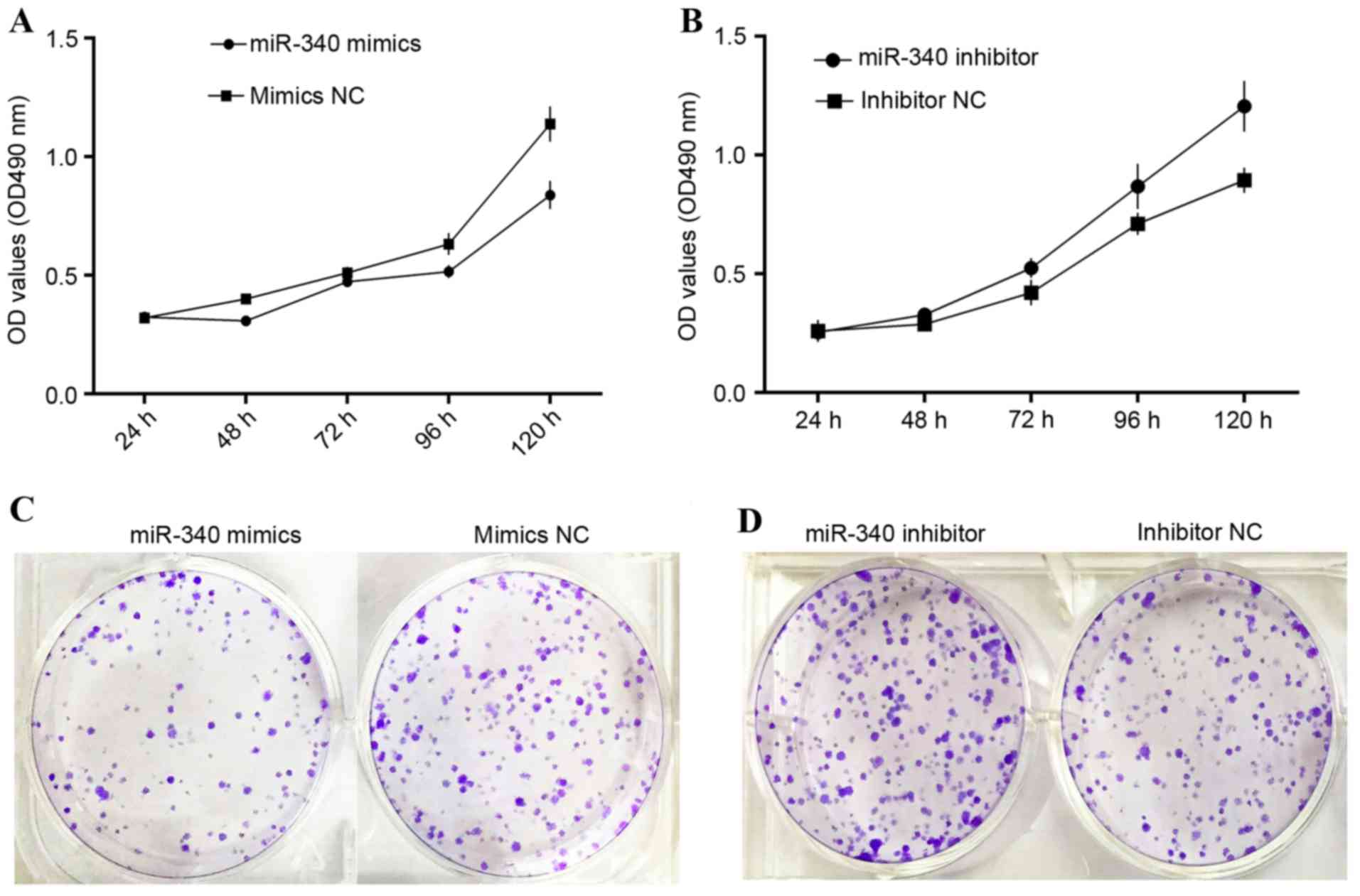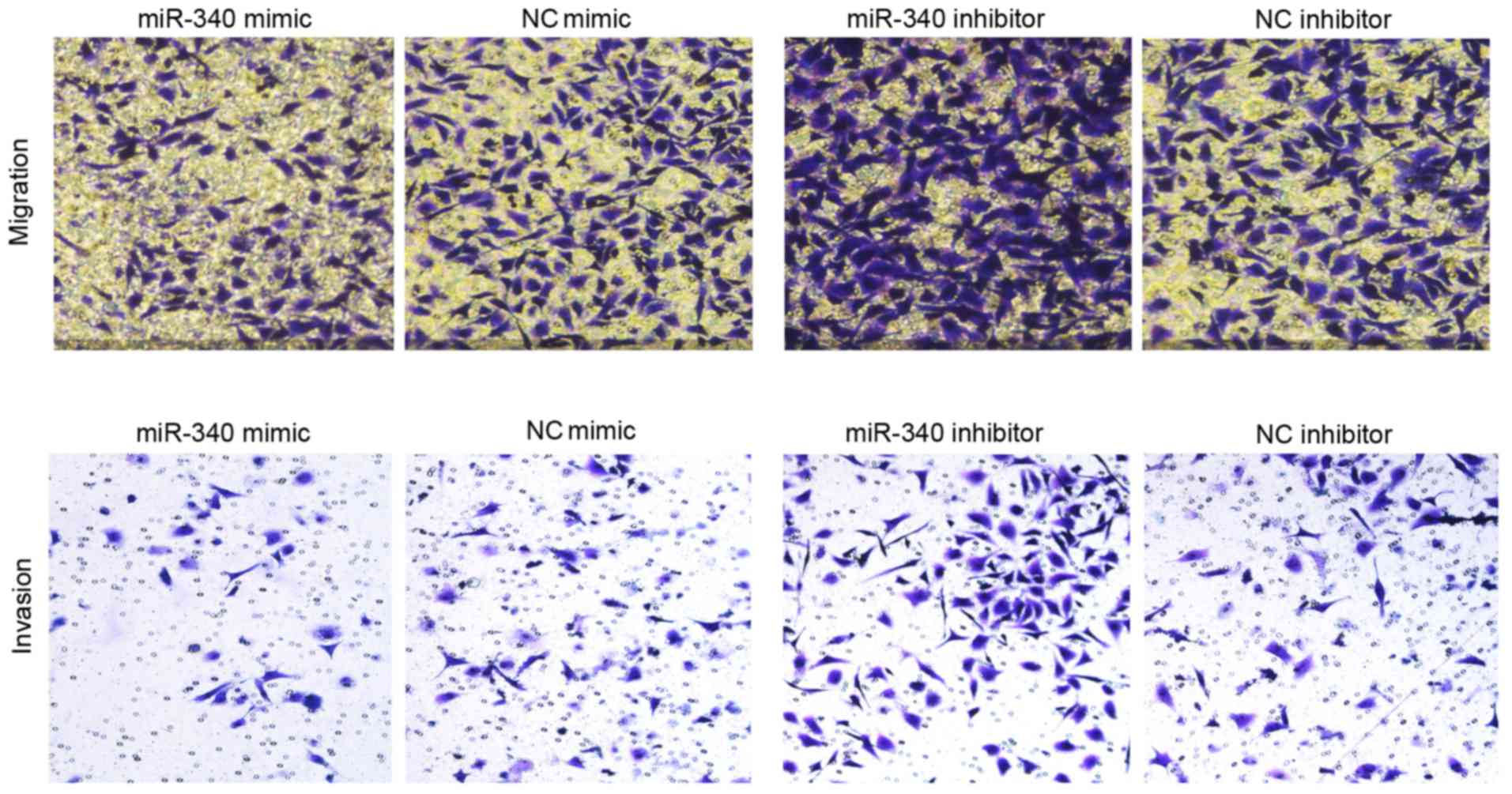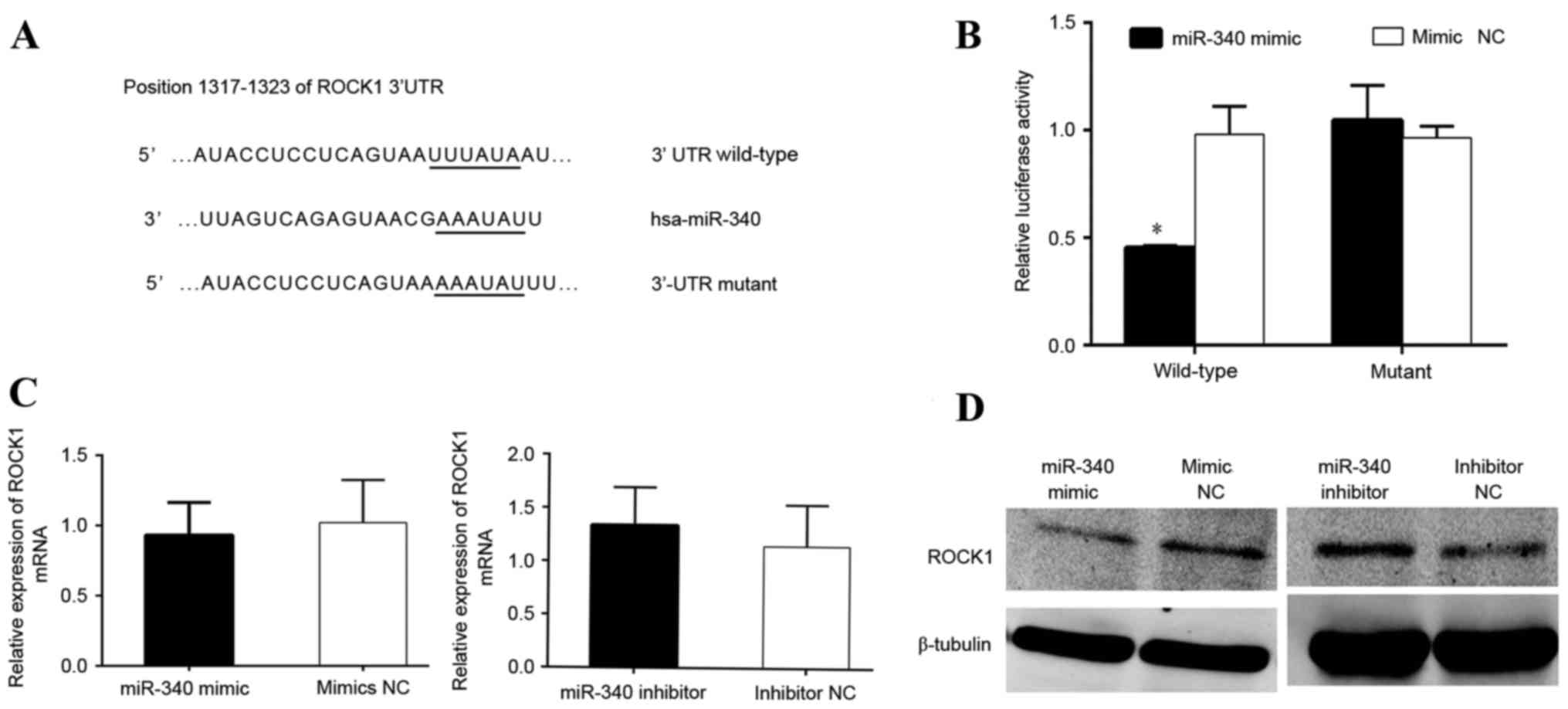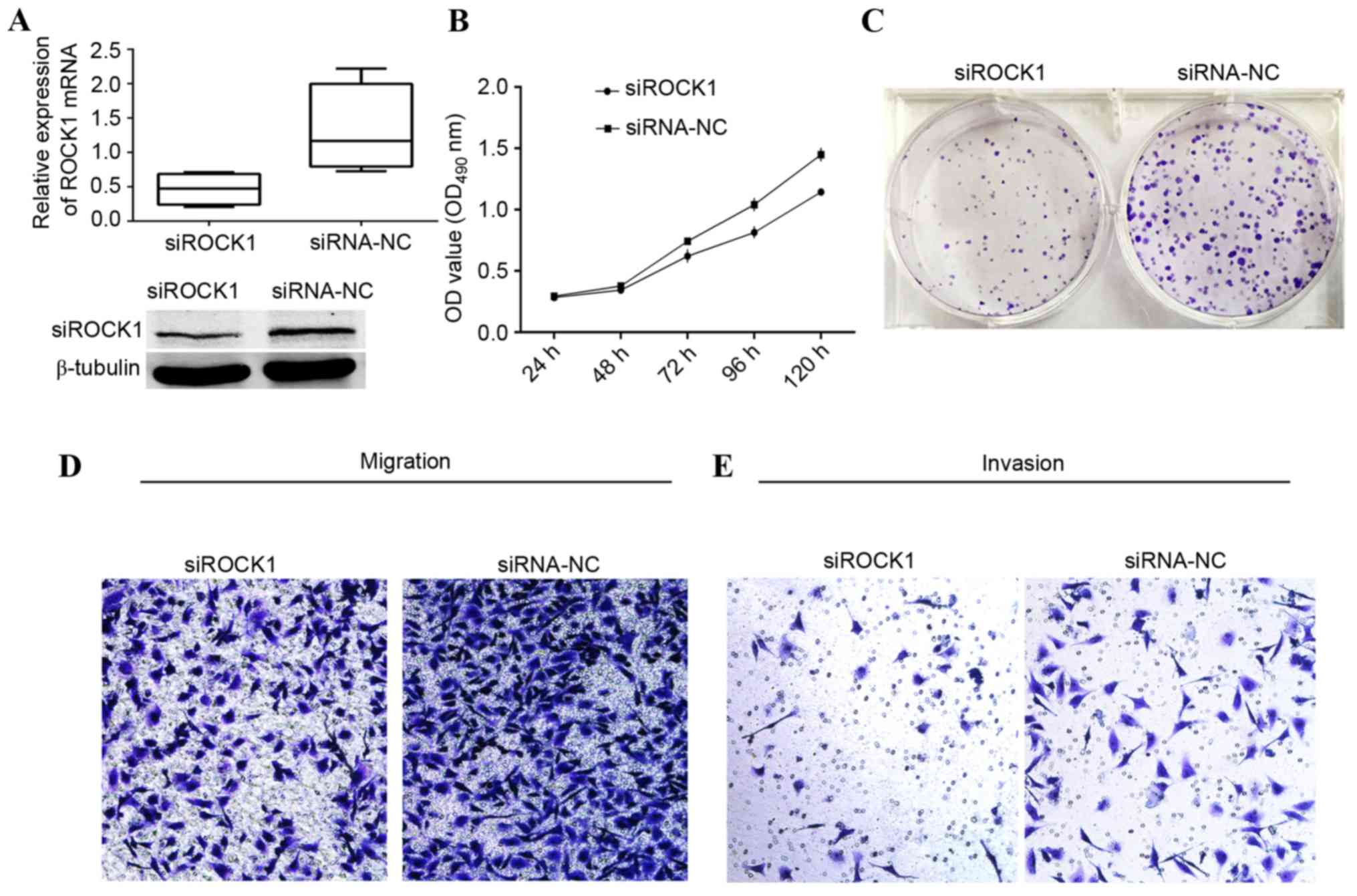Introduction
Breast cancer (BC) is the most common type of cancer
in women worldwide and is the second-leading cause of mortality in
women in the USA. In 2017, the projected number of new cases and
number of mortalities of BC were 255,180 and 41,070, respectively
in the USA (1). Although BC is
detected at an earlier stage than it was in the past, the mortality
rate of BC remains high; as many as 1 in 8 women may develop BC
(2). Patients with triple-negative BC
(TNBC) have the poorest outcome, owing to the high risk of
metastatic progression and an absence of targeted treatments
(3). The prognosis of BC can,
therefore, be poor. The development of drug resistance and a poor
understanding of the molecular mechanism by which BC progresses are
two primary reasons behind the poor prognosis of BC (4–6). This
frequent poor prognosis has led to a substantial interest in the
quest for a novel predictive marker for BC.
MicroRNAs (miRNAs/miRs) are 19–25 nucleotide-long,
non-coding RNAs that function as negative regulators of gene
expression at the post-transcriptional level. miRNAs are
transcribed by RNA polymerases II and III, and, following a series
of cleavage steps, form mature miRNA. The regulatory function of
miRNAs is mediated by the RNA-induced silencing complex (7). Dysregulation of miRNAs can lead to
progression or inhibition of normal cell growth patterns, thus
leading to oncogenesis (8). miR-340
suppresses cell migration and invasion by targeting myosin X in BC
(9), whereas miR-340 suppresses
prostate cancer cell growth by targeting high-mobility group
nucleosome binding domain 5 (10).
miR-340 suppresses glioblastoma multiforme cells by targeting the
Rho-associated, coiled-coil containing protein kinase 1 (ROCK1)
gene (11). A previous study revealed
that decreased miR-340 expression in bone marrow was associated
with liver metastasis in colorectal cancer (12). miR-340 inhibits the migration,
invasion and metastasis of BC cells by targeting the Wnt pathway
(13). The aforementioned studies
suggest that miR-340 acts as a tumor suppressor.
ROCK1 belongs to the AGC family of serine/threonine
kinases. The human ROCK1 gene is located on human chromosome 18, at
position 18q11.1. ROCK1 normally regulates the actin cytoskeleton
through the phosphorylation of substrates and modulation of
actin-myosin contractility. It also acts as a key modulator in the
formation of focal adhesions, cell motility and tumor cell
invasion, thus contributing to the regulation of morphology, gene
transcription, proliferation, differentiation, apoptosis and
oncogenic transformation (14).
In the present study, ectopic expression of miR-340
was observed to inhibit cell proliferation, migration and invasion
in vitro. ROCK1 was identified as a direct target of miR-340
and was shown to function as a tumor suppressor by downregulating
ROCK1, suggesting that it has potential as a diagnostic and
therapeutic marker in the treatment of BC.
Materials and methods
Cell lines, culture and
transfection
The human BC MDA-MB-231 cell line was purchased from
the Chinese Academy of Sciences (Shanghai, China). The cells were
cultured in high-glucose Dulbecco's modified Eagle's medium (DMEM;
Gibco; Thermo Fisher Scientific, Inc., Waltham, MA, USA)
supplemented with 10% fetal bovine serum (FBS; Gibco; Thermo Fisher
Scientific, Inc.), penicillin (100 U/ml) and streptomycin (100
µg/ml) (Sigma-Aldrich; Merck KGaA, Darmstadt, Germany). The cells
were incubated at 37°C in a humidified chamber with 5%
CO2. MDA-MB-231 cells were cultured in 6-well plates.
When the logarithmic cell growth reached 50–70% confluence, cells
were transfected with miR-340 mimics, miR-340 inhibitor or short
interfering RNA (siRNA) of ROCK1 (Shanghai Integrated Biotech Co.,
Ltd., Shanghai, China) at a concentration of 100 nM/l using
Lipofectamine 2000 (Invitrogen; Thermo Fisher Scientific, Inc.),
according to the manufacturer's protocol. All transfections were
performed in triplicate. The sequences were as follows: miR-340
mimics sense, 5′-UUAUAAAGCAAUGAGACUGAUU-3′ and antisense,
5′-UCAGUCUCAUUGCUUUAUAAUU; NC mimics sense,
5′-UCACAACCUCCUAGAAAGAGUAGA-3′ and antisense,
5′-UACUCUUUCUAGGAGGUUGUGAUU; miR-340 inhibitor,
5′-AAUCAGUCUCAUUGCUUUAUAA-3′; inhibitor NC,
5′-AAUCAGUCUCAUUGCUUUAUAA-3′; si-ROCK1 sense,
5′-UGAUGCAAAGAUUGUACUCTT and antisense,
5′-GAGUACAAUCUUUGCAUCATT-3′.
Reverse transcription-quantitative
polymerase chain reaction (RT-qPCR)
The expression level of ROCK1 was analyzed by
RT-qPCR. RNA was extracted from mimic-transfected cells using
TRIzol reagent (Invitrogen; Thermo Fisher Scientific, Inc.).
Complementary DNA was synthesized by RT using a PrimeScript RT-PCR
kit, according to the manufacturer's protocol (Takara Bio, Inc.,
Otsu, Japan). qPCR was performed on a 7900HT Fast Real-Time PCR
system (Applied Biosystems; Thermo Fisher Scientific, Inc.). The
RT-qPCR was performed using KAPA SYBR® FAST Universal qPCR kit
(cat. no. kk 4601; Kapa Biosystems, Inc., Wilmington, MA, USA). The
qPCR steps were as follows: 5 min at 95°C, followed by 40 cycles of
95°C for 30 sec and 65°C for 45 sec. GAPDH was used as the
reference. For quantitative analysis, relative gene expression
levels were calculated using the 2−ΔΔCq method (10). Expression of messenger RNA (mRNA) was
assessed by evaluating quantification cycle values. The primer
sequences were: ROCK1 forward, 5′-AACATGCTGCTGGATAAATCTGG-3′ and
reverse, 5′-TGTATCACATCGTACCATGCCT-3′; and GAPDH forward,
5′-ACAACTTTGGTATCGTGGAAGG-3′ and reverse,
5′-GCCATCACGCCACAGTTTC-3′. The experiment was performed in
triplicate.
Cell proliferation assay
The effect of miR-340 and siRNA of ROCK1 on cell
viability was measured using an MTT assay kit (Sigma-Aldrich; Merck
KGaA) according to the manufacturer's protocol. In brief, cells
(2×103 cells/well) transfected with miR-340 mimics,
miR-340 inhibitors or siRNA of ROCK1 and their corresponding
negative mimics were seeded into 96-well culture plates (BD
Biosciences, Franklin Lakes, NJ, USA) and incubated overnight at
37°C in 5% CO2. Cell proliferation was assessed at 24,
48, 72, 96 and 120 h, following the addition of 5 mg/ml MTT
solution. After 4 h of incubation, the medium was replaced with 150
µl dimethyl sulfoxide (Sigma-Aldrich; Merck KGaA) and vortexed for
10 min. The absorbance was measured using a microplate reader at
490 nm. Each experiment was performed in triplicate.
Colony formation assay
MDA-MB-231 cells (2×103 cells/well) were
transfected with miR-340 mimics, miR-340 inhibitors, a siRNA
targeting ROCK1 and their corresponding negative mimics. At 24 h
post-transfection, the cells were digested with trypsin and
resuspended into single-cell status (determined by microscopy). A
total of 500 cells from each group were cultured in a 6-well plate
for 14 days. The cells were then fixed with 4% paraformaldehyde and
stained with freshly prepared 0.1% crystal violet stain for 10 min.
Following rinsing with distilled water, the colonies that had
formed in each well were counted under microscopy (inverted
microscope; Olympus CKX41, Shibuya, Tokyo, Japan) using ×40
magnification. Each experiment was performed in triplicate.
Transwell invasion and migration
assays
A Transwell invasion assay was performed to evaluate
cell invasion ability. The filters (Corning Incorporated, Corning,
NY, USA) were washed with serum-free DMEM and placed into the wells
of a 24-well plate. The lower chamber contained DMEM with 10% FBS.
For the upper chambers, 5×104 cells resuspended in 200
µl DMEM with 0.1% bovine serum albumin (Sigma-Aldrich; Merck KGaA)
were plated in the top chamber of the Transwell chamber (Corning
Incorporated) with a 2 mg/ml Matrigel-coated membrane containing
8-mm diameter pores. Plates were then incubated at 37°C in 5%
CO2. After 18 h, cells remaining on the upper membrane
surface were removed by scrubbing with a cotton swab, while cells
on the lower surface of the membrane were fixed in 10% formalin at
room temperature for 30 min and stained with 0.5% crystal violet.
Images of six randomly selected fields of view were captured by
inverted microscopy (LI-COR Biosciences, Lincoln, NE, USA) and the
cells were counted at a magnification of ×200. For the migration
assay, the transfected cells (2×104 cells per Transwell
chamber) were placed in the top chamber without Matrigel. After 18
h, the migrated cells were lysed in glacial acetic acid and the
solutions were transferred to a 96-well culture plate for the
colorimetric reading of optical density at 560 nm. Each experiment
was performed in triplicate.
Dual-luciferase reporter assay
HEK 293T human embryonic kidney cells were provided
by the Department of Central Laboratory, Shanghai People's Tenth
Hospital (Shanghai, China). The cells were stored in liquid
nitrogen at −191°C. These cells were seeded in 24-well plates (BD
Biosciences) and cultured until the cells reached 80–90%
confluence. The 3′-untranslated region (UTR) of ROCK1 containing
the putative miR-340 binding site was amplified from genomic DNA
via PCR in a total volume of 50 µl according to the manufacturer's
protocol. The reagents (Takara Bio, Inc., Otsu, Japan) used were 2X
primer STAR GC buffer, dNTP Mixture, Primer1, Primer2, H20 and
PimerSTAR HS DNA polymerase (Takara Bio, Inc.). The PCR steps were
as follows: 94°C for 30 sec, 55°C for 30 sec and 72°C for 12 sec
(30 cycles). The ROCK1 primers used were: Forward,
5′-AACATGCTGCTGGATAAATCTGG-3′ and reverse,
5′-TGTATCACATCGTACCATGCCT-3′. The corresponding mutant constructs
were created by mutating the seed regions of the miR-340 binding
sites (5′-UUUAUA-3′ to 5′-AAAUAU-3′). Fragments were subcloned into
the Xhol site in the 3′-UTR of Renilla luciferase of
the psiCHECK-2 reporter vector (Kapa Biosystems, Inc., Wilmington,
MA, USA). HEK293T cells were transiently co-transfected with 0.2 µg
psiCHECK-2/ROCK1 3′-UTR or psiCHECK-2/ROCK1 3′-UTR mutant receptor
plasmids, together with 100 nmol/l miR-340 or negative control
miRNA (miR-NC) using Lipofectamine 2000 (Invitrogen; Thermo Fisher
Scientific, Inc.), according to the manufacturer's protocol.
Luciferase activity was examined at 48 h after transfection using
the Dual-Luciferase Reporter Assay system (Promega Corporation,
Madison, WI, USA) and normalized to firefly luciferase activity.
The ratio of Renilla:firefly luciferase was plotted. Three
independent experiments were performed in triplicate.
Western blot analysis
Cells were lysed using radioimmunoprecipitation
assay buffer (Sigma-Aldrich; Merck KGaA) and the protein
concentrations were quantified using a Pierce BCA Protein Assay kit
(Pierce; Thermo Fisher Scientific, Inc.). Proteins (50 µg) were
separated using 10% SDS-PAGE and transferred to a nitrocellulose
membrane (Beyotime Institute of Biotechnology, Jiangsu, China). The
membrane was blocked with 5% skimmed milk for 1 h. The membrane was
immunoblotted overnight at 4°C with primary antibodies against
ROCK1 (dilution, 1:500; cat. no. 4035; Cell Signaling Technology,
Inc., Danvers, MA, USA) and β-tubulin (dilution, 1:1,000; cat. no.
CW0098M; CWBio, Jiangsu, China) as a loading control. The membrane
was treated with a horseradish peroxidase-conjugated secondary
antibody (dilution, 1:2,000; cat. nos. 35571 and 35569; Thermo
Fisher Scientific, Inc.) for 1 h at room temperature.
Immunoreactive protein bands were detected with an Odyssey Scanning
System (LI-COR Biosciences, Lincoln, NE, USA).
Clinical data analysis
The Cancer Genome Atlas (TCGA) provides a large
amount of clinical data concerning different cancer types (15). Data on invasive BC were obtained from
TCGA and analyzed using starBase v2.0 (16) and PROGgeneV2 (17) to assess miRNA expression level and
overall survival rate, respectively. miR-340 expression was
compared against ROCK1 expression in 780 patient samples and
miR-340 overall survival was assessed at median miRNA
expression.
Statistical analysis
GraphPad Prism version 6.0 (GraphPad Software, Inc.,
La Jolla, CA, USA). Pearson correlations and Kaplan-Meier analysis
were used for all statistical analysis. Data were presented as the
mean ± standard deviation from at least three separate experiments.
A t-test (two-tailed) was used to compare between groups. P<0.05
was considered to indicate a statistically significant
difference.
Results
Patients and BC cell MDA-MB-231
expression data support miR-340 and ROCK1 axis
Previous studies have analyzed the role of miR-340
in the development and progression of BC (5,9). A
significant negative correlation was observed between miR-340 and
ROCK1 expression using the TCGA BC clinical patient dataset
(r=0.286; P<0.01; Fig. 1A).
Analysis of the TCGA dataset also highlighted the prolonged overall
patient survival that correlated with miR-340 expression in BC
(P<0.05; Fig. 1B).
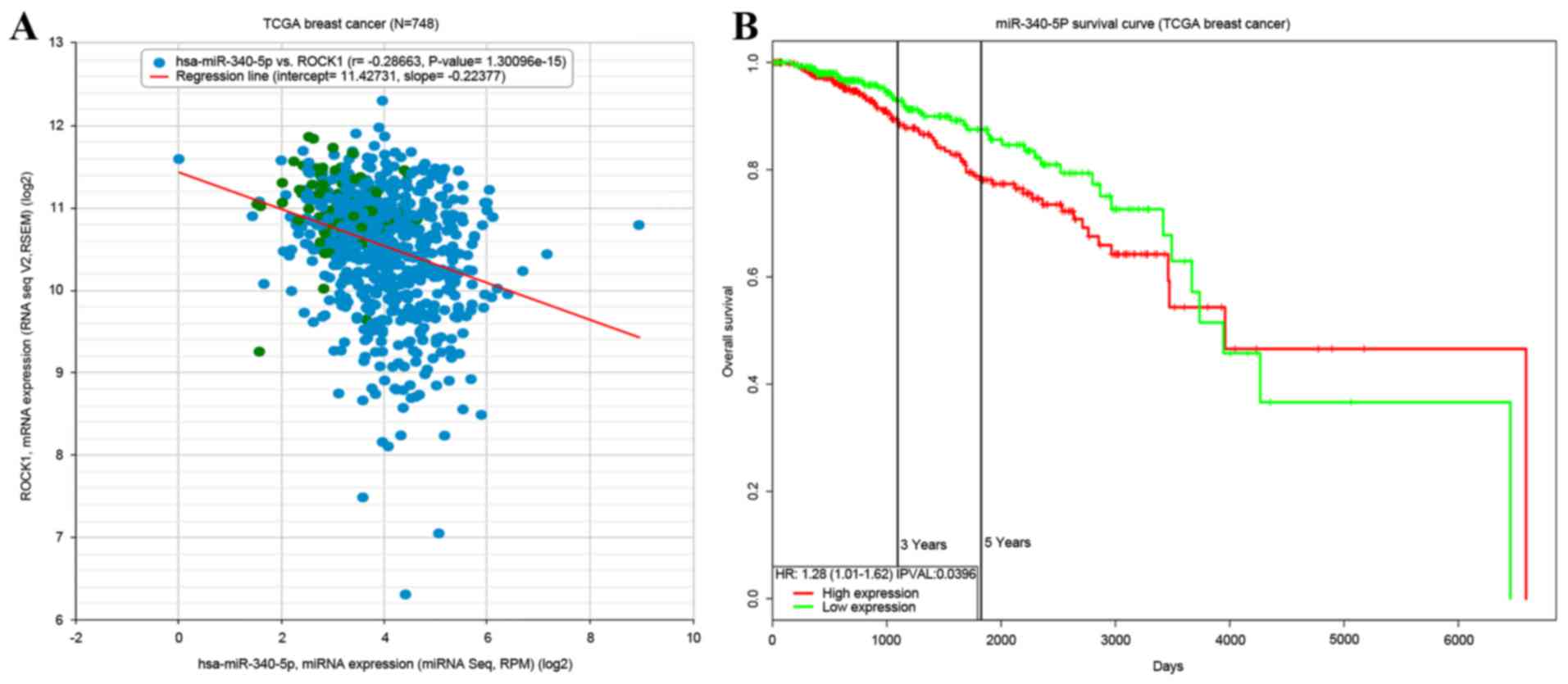 | Figure 1.TCGA BC data analysis. (A) Scatter
plot showing the negative correlation between the expression levels
of miR-340 and ROCK1 in 748 samples of patients with BC in the TCGA
dataset (Pearson correlation, r=−0.286; P<0.01). (B)
Kaplan-Meier curve of overall survival in the TCGA BC dataset. To
determine the groups of high and low expression, the dataset was
divided at the median miRNA expression. P<0.05, high expression
vs. low expression. TCGA, The Cancer Genome Atlas; BC, breast
cancer; ROCK1, Rho-associated, coiled-coil containing protein
kinase 1; NC, negative control; miR/miRNA, microRNA; HR, hazard
ratio; Seq, sequence; RPM, reads per million; RSEM, RNA-Seq by
Expectation-Maximization; hsa, Homo sapiens. |
miR-340 suppresses MDA-MB-231 cell
proliferation
The viability of cells transfected with miR-340
mimics and miR-340 inhibitors was compared with that of cells
transfected with the corresponding miR-NCs at 24, 48, 72, 96 and
120 h post-transfection. Cells transfected with miR-340 mimics grew
more slowly than control cells, whereas cells transfected with
miR-340 inhibitors grew more rapidly than control cells at multiple
time points (24, 48, 72, 96 and 120 h; Fig. 2A and B). Cells transfected with
miR-340 mimics exhibited fewer colonies than NC groups, as
determined by colony formation assays. miR-340 mimics decreased
cell proliferation, whereas miR-340 inhibitors promoted it
(Fig. 2C and D). These results
suggest that the transient overexpression of miR-340 suppressed the
proliferation and colony forming ability of MDA-MB-231 cells.
miR-340 suppresses MDA-MB-231 cell
migration and invasion
Cells transfected with miR-340 mimics, miR-340
inhibitors and their corresponding NCs were tested for their
migratory and invasive abilities. Images were obtained using an
inverted microscope at ×200 magnification. A total of three areas
were randomly slected and the cells were counted (Fig. 3). The results demonstrated that
miR-340 inhibited the migration and invasion of MDA-MB-231 cells
whereas miR-340 inhibitor promoted the migration and invasion of
MDA-MB-231 cells. These results indicate that the overexpression of
miR-340 suppressed the migratory and invasive abilities of
MDA-MB-231 cells.
ROCK1 is a target gene of miR-340
Bioinformatics analysis revealed that miR-340 binds
to putative target sequences at position 1,317–1,723 of the ROCK1
3′-UTR (Fig. 4A). To confirm that
ROCK1 was a direct target of miR-340, luciferase reporter
constructs containing wild-type and mutant 3′-UTR of the ROCK1 gene
were engineered. The luciferase reporter assay revealed that
miR-340 significantly decreased the luciferase activity of ROCK1
3′-UTR wild-type but not that of the 3′-UTR mutant in HEK293T cells
(Fig. 4B). RT-qPCR and western blot
analyses revealed that the overexpression of miR-340 significantly
downregulated the expression of ROCK1 at the mRNA and protein
levels in MDA-MB-231 cells (Fig. 4C and
D).
Expression of ROCK1 is downregulated
by ROCK1-siRNA and the growth of MDA-MB-231 cells is inhibited by
ROCK1-siRNA
The aforementioned results prompted an examination
of whether the suppressive effect of miR-340 was mediated by
repression of ROCK1 in MDA-MB-231 cells. The knockdown efficiency
of ROCK1 was verified by RT-qPCR and western blot analyses. The
expression level of ROCK1 was significantly decreased in MDA-MB-231
cells transfected with siRNA of ROCK1, when compared with that of
the siRNA NC group, at the gene and protein levels (Fig. 5A). The effect of ROCK1 silencing on
cell viability was determined by MTT assay over a period of 5 days.
The growth curve revealed a clear decrease in cell number in the
MDA-MB-231 cells that had been transfected with siRNA targeting
ROCK1 from day 2, compared with that in the control group (Fig. 5B). The total number of colonies formed
by MDA-MDA-231 cells transfected with 100 nM siRNA of ROCK1 was
visibly decreased compared with that in the control group (Fig. 5C). Furthermore, ROCK1 silencing
significantly suppressed the migration and invasion of MDA-MDA-231
cells (Fig. D and E), similar to the
effect induced by miR-340. Taken together, these findings indicated
that ROCK1 is a target of miR-340 that was involved in the
suppression of the proliferation, migration and invasion of
MDA-MB-231 cells.
Discussion
A number of studies have identified essential roles
for miRNAs and genes in the cell growth and viability of BC
(18–20). Normal tissue may have accumulated
numerous detectable mutations, since breast tissue undergoes clonal
expansion with more cell division compared with normal cells, which
may lead to hypermutability (21).
This clearly indicates the requirement for novel therapies to cure
BC. With this hope, the current study aimed to investigate the role
of miR-340 in the tumor growth and metastasis of BC.
Although there are numerous reports of aberrant
miRNA expression in cancer (22,23), data
on the involvement of miR-340 in cancer are limited and few
potential targets have been identified. A previous study reported
that the target genes of miRNAs have similar functions; miR-340 was
observed to mimic the effects of transforming growth factor-β
activation, inhibiting cell proliferation by modulating cell
scattering and cell-cycle arrest in lung cancer (24). The expression of miR-340 in
glioblastoma is responsible for a strong tumor-suppressive effect
in long-term survivors by downregulating the NRAS proto-oncogene
(25). miR-340 inhibits prostate
cancer cell proliferation and metastasis by targeting the mouse
double minute 2 homolog-tumor protein 53 signaling pathway
(26). miR-340 inhibits esophageal
cancer cell growth and invasion by targeting phosphoserine
aminotransferase (27). miR-340
inhibits the migration, invasion and metastasis of BC cells by
targeting the Wnt pathway (13).
These studies, together with the results of the present study,
confirm that miR-340 acts as a tumor-suppressor agent.
In the present study, ROCK1 was identified as a
target of miR-340 and revealed that miR-340 overexpression is
correlated with ROCK1 downregulation, leading to the inhibition of
cell proliferation, migration and invasion. ROCK1 exists in a
closed inactive conformation under quiescent conditions and is
activated by direct binding of guanosine triphosphate-loaded Rho
(28). ROCK activity and signaling
are key elements in invasive and metastatic cancer cell behavior.
ROCK kinase activity is greatly influenced by the expression of
inhibitory proteins, including dihydropyrimidinase-like 2 and
myosin-binding protein H (29). ROCK1
forms the stable actinomyosin filament bundles that initiate
front-back and dendritic spine polarity (30). Furthermore, hypoxia-inducible factors
mediate coordinated RhoA-ROCK1 expression and signaling in BC
cells, which highlights the importance of targeting ROCK1 in the
treatment of BC (31).
Although the exact mechanism underlying the
miRNA-mediated regulation of ROCK1 is not clear, ROCK1 has been
identified as a target of several miRNAs involved in carcinogenesis
and tumor progression. In hepatocellular carcinoma, miRNA-145
suppresses cell proliferation and motility by inhibiting ROCK1
(32). The miRNA-mediated regulation
of ROCK1 expression has also been observed in rectal cancer, in
which miR-144 acts as a tumor suppressor by directly targeting
ROCK1, and inhibiting the migration and proliferation of rectal
cancer cells (33). Recently, miR-145
was reported to inhibit growth and migration by targeting ROCK1 in
BC cells (34). These reports support
the present findings, which indicate that the growth and invasion
of MDA-MB-231 cells may be partly regulated by the
miR-340-dependent modulation of ROCK1 expression.
In conclusion, the present study demonstrated that
increased expression of miR-340 inhibited the proliferation,
migration and invasion of MDA-MB-231 cells. The tumor-suppressor
function of miR-340 was mediated by the downregulation of its
downstream target gene ROCK1. These results suggest that miR-340
may act as a tumor-suppressor agent whose downregulation may
contribute to the progression and metastasis of TNBC.
Acknowledgements
The present study was supported by grants from the
National Natural Science Foundation of China (grant no. 82172240)
and Shanghai Science Committee Foundation (grant no.
10411964700).
References
|
1
|
Siegel RL, Miller KD and Jemal A: Cancer
statistics, 2017. CA Cancer J Clin. 67:7–30. 2017. View Article : Google Scholar : PubMed/NCBI
|
|
2
|
Oeffinger KC, Fontham ET, Etzioni R,
Herzig A, Michaelson JS, Shih YC, Walter LC, Church TR, Flowers CR,
LaMonte SJ, et al: Breast cancer screening for women at average
risk: 2015 guideline update from the American Cancer Society. JAMA.
314:1599–1614. 2015. View Article : Google Scholar : PubMed/NCBI
|
|
3
|
Foulkes WD, Smith IE and Reis-Filho JS:
Triple-negative breast cancer. N Engl J Med. 363:1938–1948. 2010.
View Article : Google Scholar : PubMed/NCBI
|
|
4
|
Vu T and Claret FX: Trastuzumab: Updated
mechanisms of action and resistance in breast cancer. Front Oncol.
2:622012. View Article : Google Scholar : PubMed/NCBI
|
|
5
|
Scaltriti M, Rojo F, Ocaña A, Anido J,
Guzman M, Cortes J, Di Cosimo S, Matias-Guiu X, y Cajal S Ramon, et
al: Expression of p95HER2, a truncated form of the HER2 receptor
and response to anti-HER2 therapies in breast cancer. J Natl Cancer
Inst. 99:628–638. 2007. View Article : Google Scholar : PubMed/NCBI
|
|
6
|
Browne BC, O'Brien N, Duffy MJ, Crown J
and O'Donovan N: HER-2 signaling and inhibition in breast cancer.
Curr Cancer Drug Targets. 9:419–438. 2009. View Article : Google Scholar : PubMed/NCBI
|
|
7
|
Macfarlane LA and Murphy PR: MicroRNA:
Biogenesis, function and role in cancer. Curr Genomics. 11:537–561.
2010. View Article : Google Scholar : PubMed/NCBI
|
|
8
|
Pillai RS: MicroRNA function: Multiple
mechanisms for a tiny RNA? RNA. 11:1753–1761. 2005. View Article : Google Scholar : PubMed/NCBI
|
|
9
|
Chen CP, Sun ZL, Lu X, Wu WX, Guo WL, Lu
JJ, Han C, Huang JQ and Fang Y: miR-340 suppresses cell migration
and invasion by targeting MYO10 in breast cancer. Oncol Rep.
35:709–716. 2016.PubMed/NCBI
|
|
10
|
Wei P, Qiao B, Li Q, Han X, Zhang H, Huo Q
and Sun J: microRNA-340 suppresses tumorigenic potential of
prostate cancer cells by targeting high-mobility group
nucleosome-binding domain 5. DNA Cell Biol. 35:33–43. 2016.
View Article : Google Scholar : PubMed/NCBI
|
|
11
|
Huang D, Qiu S, Ge R, He L, Li M, Li Y and
Peng Y: miR-340 suppresses glioblastoma multiforme. Oncotarget.
6:9257–9270. 2015. View Article : Google Scholar : PubMed/NCBI
|
|
12
|
Takeyama H, Yamamoto H, Yamashita S, Wu X,
Takahashi H, Nishimura J, Haraguchi N, Miyake Y, Suzuki R, Murata
K, et al: Decreased miR-340 expression in bone marrow is associated
with liver metastasis of colorectal cancer. Mol Cancer Ther.
13:976–985. 2014. View Article : Google Scholar : PubMed/NCBI
|
|
13
|
Mohammadi-Yeganeh S, Paryan M, Arefian E,
Vasei M, Ghanbarian H, Mahdian R, Karimipoor M and Soleimani M:
MicroRNA-340 inhibits the migration, invasion, and metastasis of
breast cancer cells by targeting Wnt pathway. Tumour Biol.
37:8993–9000. 2016. View Article : Google Scholar : PubMed/NCBI
|
|
14
|
Livak KJ and Schmittgen TD: Analysis of
relative gene expression data using real-time quantitative PCR and
the 2(−Delta Delta C(T)) Method. Methods. 25:402–408. 2001.
View Article : Google Scholar : PubMed/NCBI
|
|
15
|
Cancer Genome Atlas Research Network, ;
Weinstein JN, Collisson EA, Mills GB, Shaw KR, Ozenberger BA,
Ellrott K, Shmulevich I, Sander C and Stuart JM: The cancer genome
atlas pan-cancer analysis project. Nat Genet. 45:1113–1120. 2013.
View Article : Google Scholar : PubMed/NCBI
|
|
16
|
Li JH, Liu S, Zhou H, Qu LH and Yang JH:
starBase v2.0: Decoding miRNA-ceRNA, miRNA-ncRNA and protein-RNA
interaction networks from large-scale CLIP-Seq data. Nucleic Acids
Res. 42(Database issue): D92–D97. 2014. View Article : Google Scholar : PubMed/NCBI
|
|
17
|
Goswami CP and Nakshatri H: PROGgeneV2:
Enhancements on the existing database. BMC Cancer. 14:9702014.
View Article : Google Scholar : PubMed/NCBI
|
|
18
|
Iorio MV, Ferracin M, Liu CG, Veronese A,
Spizzo R, Sabbioni S, Magri E, Pedriali M, Fabbri M, Campiglio M,
et al: MicroRNA gene expression deregulation in human breast
cancer. Cancer Res. 65:7065–7070. 2005. View Article : Google Scholar : PubMed/NCBI
|
|
19
|
Takahashi RU, Miyazaki H and Ochiya T: The
roles of microRNAs in breast cancer. Cancers (Basel). 7:598–616.
2015. View Article : Google Scholar : PubMed/NCBI
|
|
20
|
Al-Hajj M, Wicha MS, Benito-Hernandez A,
Morrison SJ and Clarke MF: Prospective identification of
tumorigenic breast cancer cells. Proc Natl Acad Sci USA. 100:pp.
3983–3988. 2003; View Article : Google Scholar : PubMed/NCBI
|
|
21
|
Tomlinson IP: Mutations in normal breast
tissue and breast tumours. Breast Cancer Res. 3:299–303. 2001.
View Article : Google Scholar : PubMed/NCBI
|
|
22
|
Shi L, Cheng Z, Zhang J, Li R, Zhao P, Fu
Z and You Y: hsa-mir-181a and hsa-mir-181b function as tumor
suppressors in human glioma cells. Brain Res. 1236:185–193. 2008.
View Article : Google Scholar : PubMed/NCBI
|
|
23
|
Johnson CD, Esquela-Kerscher A, Stefani G,
Byrom M, Kelnar K, Ovcharenko D, Wilson M, Wang X, Shelton J,
Shingara J, et al: The let-7 microRNA represses cell proliferation
pathways in human cells. Cancer Res. 67:7713–7722. 2007. View Article : Google Scholar : PubMed/NCBI
|
|
24
|
Gennarino VA, D'Angelo G, Dharmalingam G,
Fernandez S, Russolillo G, Sanges R, Mutarelli M, Belcastro V,
Ballabio A, Verde P, et al: Identification of microRNA-regulated
gene networks by expression analysis of target genes. Genome Res.
22:1163–1172. 2012. View Article : Google Scholar : PubMed/NCBI
|
|
25
|
Fiore D, Donnarumma E, Roscigno G, Iaboni
M, Russo V, Affinito A, Adamo A, De Martino F, Quintavalle C,
Romano G, et al: miR-340 predicts glioblastoma survival and
modulates key cancer hallmarks through down-regulation of NRAS.
Oncotarget. 7:19531–19547. 2016.PubMed/NCBI
|
|
26
|
Huang K, Tang Y, He L and Dai Y:
MicroRNA-340 inhibits prostate cancer cell proliferation and
metastasis by targeting the MDM2-p53 pathway. Oncol Rep.
35:887–895. 2016.PubMed/NCBI
|
|
27
|
Morgan-Fisher M, Wewer UM and Yoneda A:
Regulation of ROCK activity in cancer. J Histochem Cytochem.
61:185–198. 2013. View Article : Google Scholar : PubMed/NCBI
|
|
28
|
Yan S, Jiang H, Fang S, Yin F, Wang Z, Jia
Y, Sun X, Wu S, Jiang T and Mao A: MicroRNA-340 inhibits esophageal
cancer cell growth and invasion by targeting phosphoserine
aminotransferase 1. Cell Physiol Biochem. 37:375–386. 2015.
View Article : Google Scholar : PubMed/NCBI
|
|
29
|
Morgan-Fisher M, Wewer UM and Yoneda A:
Regulation of ROCK activity in cancer. J Histochem Cytochem.
61:185–198. 2013. View Article : Google Scholar : PubMed/NCBI
|
|
30
|
Newell-Litwa KA, Badoual M, Asmussen H,
Patel H, Whitmore L and Horwitz AR: ROCK1 and 2 differentially
regulate actomyosin organization to drive cell and synaptic
polarity. J Cell Biol. 210:225–242. 2015. View Article : Google Scholar : PubMed/NCBI
|
|
31
|
Gilkes DM, Xiang L, Lee SJ, Chaturvedi P,
Hubbi ME, Wirtz D and Semenza GL: Hypoxia-inducible factors mediate
coordinated RhoA-ROCK1 expression and signaling in breast cancer
cells. Proc Natl Acad Sci USA. 111:pp. E384–E393. 2014; View Article : Google Scholar : PubMed/NCBI
|
|
32
|
Ding W, Tan H, Zhao C, Li X, Li Z, Jiang
C, Zhang Y and Wang L: MiR-145 suppresses cell proliferation and
motility by inhibiting ROCK1 in hepatocellular carcinoma. Tumour
Biol. 37:6255–6260. 2016. View Article : Google Scholar : PubMed/NCBI
|
|
33
|
Cai SD, Chen JS, Xi ZW, Zhang LJ, Niu ML
and Gao ZY: MicroRNA-144 inhibits migration and proliferation in
rectal cancer by downregulating ROCK-1. Mol Med Rep. 12:7396–7402.
2015.PubMed/NCBI
|
|
34
|
Zheng M, Sun X, Li Y and Zuo W:
MicroRNA-145 inhibits growth and migration of breast cancer cells
through targeting oncoprotein ROCK1. Tumour Biol. 37:8189–8196.
2016. View Article : Google Scholar : PubMed/NCBI
|
















